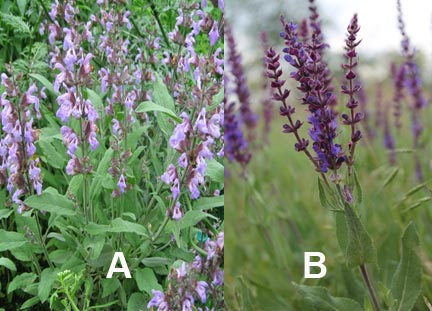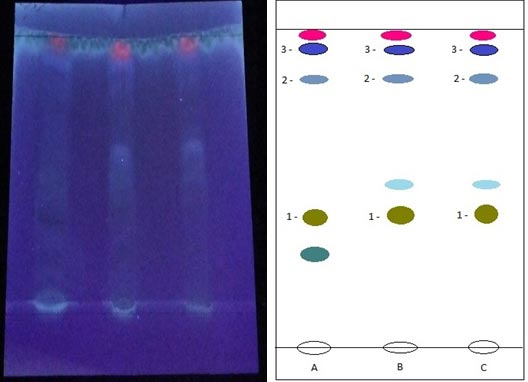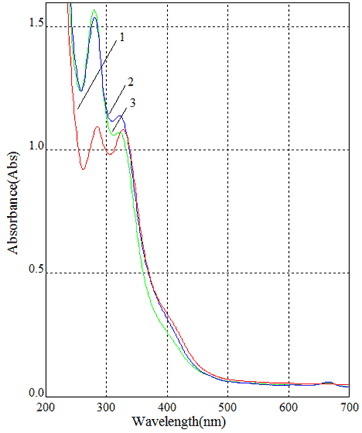2018 год № 3
Фармакология и фармация
2Оренбургский государственный медицинский университет, 460000, ул. Советская, 6, г. Оренбург
Резюме:
Ключевые слова:
2Orenburg State Medical University, Orenburg
Summary:
Key words:
Introduction
|
 |
 |
Salvia officinalis is a hoary subshrub with the grey-green stalks and leaves and height under 500 mm. Stalks are numerous, branchy, tetrahedral with lignification in the foundation. Leaves are stalked, opposite, oblong with dull top and with cut lappet on foundation. Flowers 6 - 8 are gathered in the whorl. Bells are bilabiate and hoary. Crowns are bilabiate and blue-violet, 2 stamens which covered with upper labium. Salvia tesqicola is a perennial herbaceous plant with height 300-600 mm. Apical inflorescence has 1 - 2 side branch (es). Bells are bilabiate, hoary violet or reddish color. Crowns are bilabiate and blue-violet 10 - 13 mm. Leaves are folded, oblongly-oval, toothed on the sides, hoary. Stalk is also covered with filaments (fig. 1) [Sankov, 2001; Tichonov, 2004].
The genus Salvia includes more than 1000 species but only some of them are used in the official medicine. Salvia officinalis possess anti-inflamatory, astringent, bactericidal, gastroprotective and some other properties due to the chemical composition, which involves essential oil, diterpen acids, tannins and flavonoids [Golovkin, 2001; Kurkin, 2007; Kurkin, 2009; Muravyova eе al., 2002; State Pharmacopeia of Belarus Repablic, 2009; State Pharmacopeia of Russian Federation, 2015; European pharmacopeia, 2014; Adzet, 1986]. Unfortunately, the cultivation area of Salvia officinalis is limeted.
However the central part of Russia, including the Orenburg region, is a habitat for some closely related species. Salvia tesquicola is one of them. Leaves of Salvia officinalis are well researched in contrast to raw material of Salvia tesquicola. However, there is no methods for qualitative and quantitative analysis of phenolic compounds in the officinal medicinal agent - Leaves of Salvia offcinalis, despite it is one of leading group. Due to the closeness of these species, we decided to compare their chemical compositions, using methods described in literature [Gavrilin et al., 2010; Zapesochnya, 1996; Trease, 2009].

Рис. 1. Объекты исследования: А - Шалфей лекарственный, B - Шалфей сухостепной
Fig. 1. The objects of present research: А - Salvia officinalis, B - Salvia tesquicola
Aim
|
 |
 |
The aim of present work was the comparative qualitative and quantitative determination of phenolic compounds from raw material of Salvia officinalis and Salvia tesquicola.
The tasks of the present research were following:
1) The qualitative analysis of the samples of raw material of Salvia officinalis (leaves) and salvia tesquicola (leaves and herbs) using thin layer chromatography.
2) The quantitative analysis of the samples of raw material of Salvia officinalis (leaves) and salvia tesquicola (leaves and herbs) using the method of spectrophotometry at a wavelength of 254 nm.
Materials and Methods
|
 |
 |
Raw material of Salvia tesquicola was prepared during 2016 in the territory of Orenburg region. Herbs and leaves as the raw material were air-dried in the shade. Industrial samples of medical raw material of Salvia officinalis (leaves) were used.
Thin layer chromatography was performed using an aluminium coated plate "Sorbfil PTLC-AF-A-UV" and the eluent system - ethylacetate : formic acid : water=90:6:6. The plate was kept for one hour at the temperature 100°C. After that it was spotted with 70 % ethanolic sample solutions and was examined in UV light (λ=365 nm, λ=254 nm) [Gird et al., 2014; Kirchner, 1991; Minina, 2009; Dean, 1985].
The technique of quantitative determination of gallic acid in medical raw material of Salvia officinalis (leaves) and raw material of Salvia tesquicola (herbs and leaves). Crushed samples of one gram were placed in flasks with a grinding capacity of 100 ml, water-ethanol mixture (1:1) was added. Flasks were attached to reverse refrigerator and heated on a water bath within 60 minutes. The received extractions were filtrated through paper filters. 5 ml of the filtrates were placed in flasks with a grinding capacity of 100 ml, water-ethanol mixture (1:1) was added. The optical density of the solution was measured on the UV-spectrophotometers "UNICO 2800" at the wavelength of 276±2 nm [Gavrilin et al., 2010; Zapesochnya, 1996; Bagur, 1997.].
The content amount of gallic acid was calculated by the chemical formulation:
X%=(Dx × Vxd1 × Vxd2)/(Est × mx × Vax × l),
Where Dx - optical density of the working solution, Vx d1 (d2) - volume of dilution (first and second) of the working solution, Est - specific absorption of the standard sample, mx - the mass of raw material, g, Vax- volume of aliquot of the working solution, l - the thickness of the absorbing layer of the cell.
Results and Discussion
|
 |
 |
Thin layer chromatography analysis of phenolic compounds showed the presence of spots with the same Rf (Retardation factor) for rosmarinic acid (Rf=0,88), caffeic acid(Rf=0,93) and hyperoside (Rf=0,37) Red fluorescent spots correspond to chlorophyll (fig. 2).

Рис. 2. ТСХ фенольных соединений из листьев шалфея лекарственного (А), травы шалфея сухостепного (B), листьев шалфея сухостепного (С): 1 - гиперозид (Rf=0,37), 2 - розмариновая кислота (Rf=0,88), 3 - кофеиновая кислота (Rf=0,93)
Fig. 2. TLC of phenolic compounds from leaves of Salvia officinalis (A), herbs of Salvia tesquicola (B), leaves Salvia tesquicola (C): 1 - hyperoside (Rf=0,37), 2 - rosmarinic acid (Rf=0,88), 3 - caffeic acid (Rf=0,93)
According to spectrophotometric results, the peaks indicate the presence of gallic acid at the wavelength of 276±2 nm (fig. 3). The optical density of the standart sample of gallic acid was taken from scientific literature [Onishchenko, 2003].
The amount of phenolic compounds when recalculating on gallic acid was calculated by using the afore-mentioned formula. This content variates from 2,034 to 3,034 %. In accordance with the obtained data, the quantity of phenolic compounds is higher in leaves and herbs of Salvia tesquicola than in leaves of Salvia officinalis (table 1).
| Research objects | The mass of raw material mx | Optical density of the solution Dx | Content amount X % |
|---|---|---|---|
| Leaves of Salvia officinalis | 1,0064 | 1,0332 | 2,034 |
| Leaves of Salvia tesquicola | 1,0020 | 1,5056 | 2,964 |
| Herbs of Salvia tesquicola | 1,0035 | 1,5411 | 3,034 |
Metrological characteristics of the methodology of quantitative measurement of the amount of phenolic compounds when recalculating on gallic acid in raw material of different species of Salvia presented in table 2.

Рис. 3. Спектрофотометрический анализ галловой кислоты, полученной из листьев Шалфея лекарственного - 1, листьев шалфея сухостепного - 2, травы шалфея сухостепного - 3
Fig. 3. Spectrophotometric analysis of gallic acid in leaves of Salvia officinalis - 1, leaves of Salvia tesquicola - 2, herbs of Salvia tesquicola - 3
| Research objects | f | S | P, % | t (P, f) | ΔX | E, % | |
|---|---|---|---|---|---|---|---|
| Leaves of Salvia officinalis | 10 | 2,034 | 0,0335 | 95 | ±2,23 | ±0,0749 | ±3,7 |
| Leaves of Salvia tesquicola | 10 | 2,964 | 0,0563 | 95 | ±2,23 | ±0,1256 | ±4,2 |
| Leaves of Salvia tesquicola | 10 | 3,034 | 0,0544 | 95 | ±2,23 | ±0,1213 | ±3,9 |
Conclusions
|
 |
 |
1. The daignostically important components such as rosmarinic acid (Rf=0,88), caffeic acid (Rf=0,93) and hyperoside (Rf=0,37) were identified during thin layer chromatography analysis.
2. The quantitative analysis of the amount of phenolic compounds, when recalculating on gallic acid, in raw material of Salvia officinalis and Salvia tesquicola was made by using the method of spectrophotometry at a wavelength of 276 nm. The content of the amount of phenolic compounds, when recalculating on gallic acid, in samples of raw materials varies from 2,034 % to 3,034 %.
3. The content of phenolic compounds is large enough in leaves and herbs of Salvia tesquicola, which grows in the territory of Orenburg region, respectively this type of Salvia is perspective for further researches.
Литература
|
 |
1. Гаврилин М.В., Попова О.И., Губанова Е.А. Химия растительного сырья. - 2010. - № 4. - С. 99-104.
2. Головкин Б.И. Биологически активные вещества растительного происхождения. - М.: Наука, 2001. - 350 с.
3. Государственная фармакопея Республики Беларусь. - 2009. 3 том. - Минск: Минский государственный ПТК полиграфии им. В. Хоружей. - 727 с.
4. Государственная Фармакопея Российской Федерации. - 2015. ХIII издание. 3 том. Фармакопейная статья 2.5.00.51.15 "Листья шалфея лекарственного". - М.
5. Запесочная Г.Г. Методические основы химической стандартизации растительного сырья и фитопрепаратов. - Самара, 1996. - № 1. - 127 с.
6. Кирхнер Ю. Тонкослойная хроматография. - М.: Мир, 1981. - 1139 с.
7. Куркин В.А. Фармакогнозия: учебник для студентов фармацевтического факультета, издание 2, Самара: Офорт, 2007. - 1179 с.
8. Куркин В.А. Основы фитотерапии: учебное пособие для студентов фармацевтических вузов. - Самара: Офорт, 2009. - 963 с.
9. Минина С.А. Химия и технология фитопрепаратов. - М.: ГЭОТАР-Медиа, 2009. - 560 с.
10. Муравьева Д.А., Самылина И.А., Яковлев Г.П. Фармакогнозия: учебник. - М.: Медицина, 2002. - 656 с.
11. Онищенко Г.Г. Руководство Р 4.1.1672-03. - 2003.
12. Саньков А.Н. Лекарственные травы Оренбуржья. - Оренбург: Южный Урал, 2001. - 129 с.
13. Тихонов В.Н. Лекарственные растения, сырье и фитопрепараты. - Томск, 2004. - № 1. - 20 с.
14. Adzet T. 1986. Polyphenolic compounds with biological and pharmacological activity // Herbs Spices Medicinal Plants. - № 1. - Р. 167-184.
15. Bagur M.G. The standard addition methodology for evaluation of results in chromatographic analysis. - 1997. - № 10. - Р. 374-380.
16. Dean P.D.G. Chromalographyi. A Practical Approach - 1RL Press Oxford, England, 1985. - 215 р.
17. European pharmacopeia. - 2014. VIII edition. Vol. 2. - 1373 р.
18. Gird C.E., Nencu I., Costela T., Dutu L.E., Popescu M.L., Ciupitu N. FARMACIA. - 2014. - Vol. 62. - Р. 649-657.
19. Takeda H., Tsuji M., Inaxu M., Egashira T., Matsumiya T. Biological & Pharmaceutical bulletin 3. - 2002. - Р. 261-267.
20. Trease Evans W.C. Pharmacognosy. - Toronto: Saunders Elsevier, 2009. - 603 р.
Телефон: (4212) 76-13-96
«Дальневосточный медицинский журнал»

